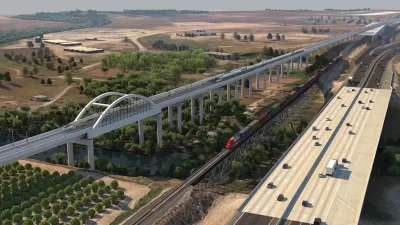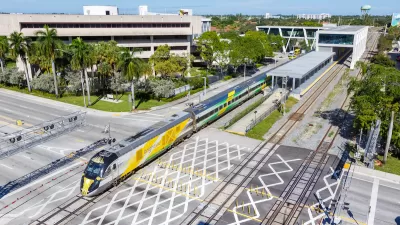Building more high-speed passenger rail in the United States could have significant economic and environmental impacts, creating jobs and reducing carbon emissions.

A new report from the Mineta Transportation Institute (MTI) calculates the potential economic and environmental benefits of expanding high-speed rail (HSR) in the United States.
According to an article in Mass Transit, these benefits include “job growth and increased economic activity, creation of an entirely new domestic manufacturing base, station area development and improved regional connectivity and reduced greenhouse gas (GHG) emissions and better land use.”
For example, “The California High-Speed Rail Authority (CHSRA) estimates high-speed rail has generated an estimated 74,000 to 80,000 jobs per year, $5.6 billion to $6 billion in labor income and $15 billion to $16 billion in economic output between 2006 and 2022.” The rail manufacturing industry also supports roughly 90,000 U.S. jobs as of 2015.
Expanding HSR could also connect megaregions, create more opportunities for housing and employment, and reduce vehicle miles driven and greenhouse gas emissions. “One study found it would cost an estimated $122-199 billion to provide the equivalent highway and airport capacity that the San Francisco to Los Angeles high-speed rail network would provide.”
FULL STORY: MTI report outlines economic and environmental benefits of high-speed rail in U.S.

Trump Administration Could Effectively End Housing Voucher Program
Federal officials are eyeing major cuts to the Section 8 program that helps millions of low-income households pay rent.

Planetizen Federal Action Tracker
A weekly monitor of how Trump’s orders and actions are impacting planners and planning in America.

Ken Jennings Launches Transit Web Series
The Jeopardy champ wants you to ride public transit.

California Invests Additional $5M in Electric School Buses
The state wants to electrify all of its school bus fleets by 2035.

Austin Launches $2M Homelessness Prevention Fund
A new grant program from the city’s Homeless Strategy Office will fund rental assistance and supportive services.

Alabama School Forestry Initiative Brings Trees to Schoolyards
Trees can improve physical and mental health for students and commnity members.
Urban Design for Planners 1: Software Tools
This six-course series explores essential urban design concepts using open source software and equips planners with the tools they need to participate fully in the urban design process.
Planning for Universal Design
Learn the tools for implementing Universal Design in planning regulations.
Ada County Highway District
Clanton & Associates, Inc.
Jessamine County Fiscal Court
Institute for Housing and Urban Development Studies (IHS)
City of Grandview
Harvard GSD Executive Education
Toledo-Lucas County Plan Commissions
Salt Lake City
NYU Wagner Graduate School of Public Service





























